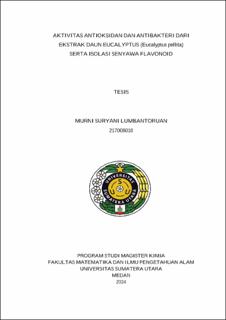Aktivitas Antioksidan dan Antibakteri dari Ekstrak Daun Eucalyptus (Eucalyptus pellita) serta Isolasi Senyawa Flavonoid
Antioxidant and Antibacterial Activity of Eucalyptus (Eucalyptus pellita) Leaves Extract and Isolation of Flavonoid Compounds

Date
2024Author
Lumbantoruan, Murni Suryani
Advisor(s)
Lenny, Sovia
Sembiring, Helmina Br
Metadata
Show full item recordAbstract
Eucalyptus pellita is one of the species from the Myrtaceae family that is considered a
potential allelopath. This study aims to test the bioactivity and isolate flavonoid compound from E. pellita leaf extract. E. pellita leaf powder (1900 g) was macerated with methanol solvent, then partitioned with n - hexane and ethyl acetate solvents. Methanol extract was obtained as much as 176.75 g (9.30%), n-hexane extract 13.77 g (0.72%), and ethyl acetate extract 27.93 g (1.47%). The three extracts were screened for phytochemicals with the results of methanol extract and ethyl acetate extract
positive for flavonoids. The three extracts did not contain alkaloids but were positive for tannins and saponins. Antioxidant activity was tested using DPPH (1,1 diphenyl-
2-picrylhydrazyl) method with UV-vis spectrophotometer (λmax 517 nm). Sample concentration variations were 12.5; 25; 50; 100; and 200 ppm. Ethyl acetate extract,
methanol extract and n-hexane extract have antioxidant activity with IC50 values of 6.811; 17.923; and 31.109 ppm, respectively. Antibacterial activity test using agar diffusion method against Staphylococcus aureus, Bacillus subtilis, and Escherichia
coli bacteria was conducted at the extract concentration. Among the tested bacteria, B. subtilis showed the highest susceptibility to n- hexane extract, methanol extract and
ethyl acetate extract respectively displayed the widest zone of inhibition (14.1 mm; 14.7 mm; and 18.7 mm). This indicates that E. pellita leaf extracts have strong
antioxidant and antibacterial activities. From the results of the spectrum analysis, it was concluded that the isolated compound was a flavonoid compound of the isoflavone type, namely cudracusisoflavone.
Collections
- Master Theses [381]
